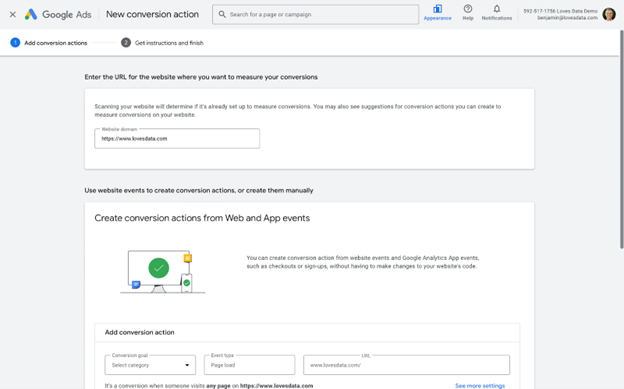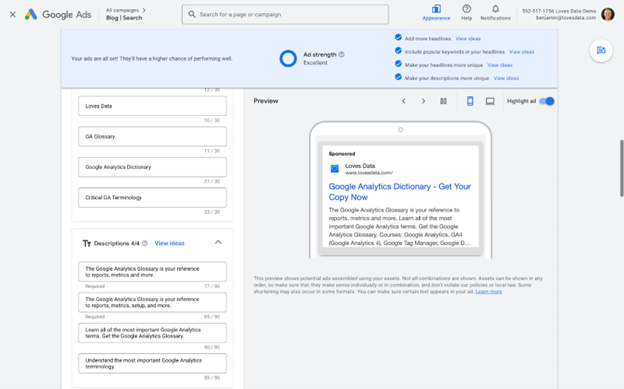How to Enhance Your Google Ads Strategy
Loves Data
Enhancing your Google Ads strategy can make all the difference in reaching your business goals. With so many features available, it can be overwhelming to know where to start. A well-rounded strategy involves understanding your audience, utilizing advanced targeting, creating compelling ad copy, and continuously analyzing performance. By focusing on these key areas, you can enhance your Google Ads strategy and achieve better results.
How to Level Up Your Google Ads Strategy
1. Understanding Your Audience and Setting Clear Goals
To enhance your Google Ads strategy, start by understanding your audience. Knowing who your potential customers are helps you craft messages that speak directly to them. Start by considering their demographics, interests, and online behavior.
Use tools like Google Analytics to gather data about your website visitors. This data provides insights into who is visiting your site, what they’re looking for, and how they interact with your content.
Once you have a clear picture of your audience, set specific goals for your Google Ads campaigns. Goals provide direction and a way to measure success. Do you want to drive more traffic to your website, increase sales, or generate leads? Your goals will determine your ad strategy. For example, if you aim to increase sales, focus on targeting users who are likely to make a purchase.

After identifying your goals, make sure they are measurable. Use the SMART criteria—Specific, Measurable, Achievable, Relevant, and Time-bound—to set effective goals. This approach keeps you focused and allows you to track your progress. Regularly review and adjust your goals based on your campaign’s performance to ensure continuous improvement.
2. Utilizing Advanced Targeting Features in Google Ads
Advanced targeting features in Google Ads help you reach the right audience more precisely. Take advantage of these features to improve the effectiveness of your campaigns. One powerful feature is demographic targeting. This allows you to target users based on age, gender, parental status, and household income. By narrowing down your audience, you can create more relevant ads.
Another useful feature is geographic targeting. You can target users in specific locations, such as cities, regions, or countries. This is valuable for businesses that serve local markets or specific geographic areas. Use location extensions to highlight your business address in your ads, making it easier for nearby customers to find you.

Behavior-based targeting is also essential. Google Ads allows you to target users based on their past online behavior. For example, if someone has visited your website or shown interest in your products, you can retarget them with customized ads. This keeps your brand top of mind and encourages them to return and convert.
By utilizing these advanced targeting features, you can ensure your ads reach the people most likely to be interested in your products or services. Tailor your targeting options to align with your campaign goals and audience insights for maximum impact.
3. Implementing Effective Ad Copy and Creative Strategies
Creating compelling ad copy and visuals is key to catching your audience's attention and driving action. Start by crafting clear and concise headlines that immediately convey your message. Use strong action verbs to encourage clicks and make sure your headlines are relevant to the keywords you're targeting.
In the description, focus on the benefits of your product or service. Highlight what makes it unique and how it solves your customer's problems. Use language that resonates with your audience while maintaining a professional tone. Including a clear call-to-action (CTA) is crucial. Phrases like "Learn More," "Get Started," or "Buy Now" tell the user exactly what to do next.

Visual elements are equally important. If you are using display ads, choose high-quality images that are relevant to your ad copy. Images should be visually appealing and professional. For video ads, ensure they are short, engaging, and get to the point quickly.
Testing different variations of your ad copy and visuals can help identify what works best. Regular updates keep your ads fresh and relevant.
4. Analyzing Performance Metrics and Optimizing Campaigns
Regularly analyzing your Google Ads performance metrics is essential for optimizing your campaigns. Key metrics to monitor include click-through rates (CTR), conversion rates, cost-per-click (CPC), and return on investment (ROI). These metrics help you understand how well your ads are performing and where you can make improvements.
Use Google Ads' built-in reporting tools to gather this data. Look for trends and patterns that can inform your strategy. For example, if a particular ad group has a high CTR but low conversion rate, you might need to reassess the landing page it’s directing to or refine your ad copy.
A/B testing is another valuable technique. Test different versions of your ads to see which performs better. This could involve changing headlines, images, or CTAs. Based on the results, adjust your campaigns to maximize performance.
Continuously optimizing your campaigns helps you get the most out of your ad spend and improves overall effectiveness.
Elevate Your Google Ads Strategy for Maximum Impact
Enhancing your Google Ads strategy involves understanding your audience, utilizing advanced targeting, crafting effective ad copy, and analyzing performance metrics. Each of these elements plays a vital role in ensuring your campaigns are successful. By focusing on these areas, you can create ads that resonate with your audience and achieve your business goals.
Ready to take your Google Ads strategy to the next level? Explore Loves Data’s Google Ads courses and GA4 courses for expert guidance and tips tailored to help you succeed. Sign up today and start optimizing your campaigns for better results!



Comments